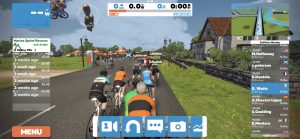
” A change of speed, a change of style. A change of Scene with no regrets…”
Its that time of year again. Not the New Year resolutions that will be forgotten about by the end of next week or that expensive gym membership you took out last week only to be rendered superfluous by half term. Good intentions, well meant and all that. No, I was referring to the fact that for the majority, we are now into a new sales year and I am wondering how many of you have a plan to achieve your quota? If you have, is it sustainable and will it last the year?
For those who have chosen sales as a vocation, planning is essential and yet it rarely comes naturally. Many sales people are “too busy” to complete Account Plans or follow a structured template for reviewing high value opportunities. Yet, when that account is halved in value and that opportunity fails to close on the designated date for the designated value, the only people seemingly surprised are those that have not done enough in the planning department.
I have spent much of the past twenty years in Sales Leadership astonished at how few of my former charges have taken this approach to what is essentially a vocation. Imagine if your gastroenterologist meandered in after a “heavy night” as the procedures were about to commence not bothering with seeing who was on the list or having a view as to who was at risk from a heavy bleed. Similarly, what if your Barrister turned up in court and decided to “wing it” rather than have a detailed understanding of your case?
However, I have seen a good few sales “professionals” arrive at pre-meetings (if they had bothered to organise them!) with a modicum of effort prior to going into what could and should have been pivotal client meetings. I have seen presentations that haven’t been visited by the spell checking fairy, a lack of knowledge as to the precise address of where we were actually going and on more than one occasion, the incorrect name of the organisation concerned. Small wonder then, that many reviews (Territory, opportunity, strategic etc) were conducted in the same “free form” and haphazard way. Sadly, it hasn’t been uncommon to see sales people (or even Sales Leaders!) completing their slides whilst their peers are presenting their own version. Unsurprising then, that several recent pieces of research suggest that >50% of sales people fail to reach their yearly quota and in some cases it can be as high as 60%.
Pretty obvious then, that structured, logical plan is therefore required (preferably) at the start of each fiscal year, or certainly within the first couple of months. Those individuals that have been around the organisation for a while will undoubtedly have pipeline. but is it enough? How do you know if it’s enough, particularly when “aggressive growth” seems to be a pre-requisite of most organisations.
Many sales organisations operate on an X cover basis, typically 3x or 4x. The irony is that if it is stringently managed, this encourages inappropriate behaviour from your sales force. My sales leadership experience suggests that after panic sets in opportunities crawl out of the woodwork like spiders after the rain. The difference is, whilst the spiders for those of us with a touch of arachnophobia are all too real, the opportunities in the pipeline rarely are. Window dressing on a grand scale occurs as the exercise becomes a means to an end. Even if some of the deals are real and even qualified, the accurate risk is never measured, largely because it is completely different selling an existing product to a new set of customers and riskier still, trying to sell a new product to a completely new entity.
Igor Ansoff, a Russian American Mathematician first devised his risk matrix to categorise pipeline opportunity based on risk. RDC have developed this further as follows:

![]()
Lowest risk is selling existing product to existing customers (defined by the same Decision Making Unit your organisation as sold to before) at 1 in 2 risk, through, new product to existing customer, (1 in 3 risk), existing product to new customer (1 in 5 risk) and perhaps the riskiest of all, New Product to New Customer. (1 in 10 risk).
Once you understand your pipeline in a structured way and can categorise your pipeline accurately, you can truly assess your true risk and more importantly, what your true gap is between your quota and your required pipeline to achieve it.
Sales Target Assurance Planning (STAP) is a structured methodology developed by RDC to enable you to plan for your sales year understand the true risk of your existing pipeline and enable your team to take the corrective action to drive the right level of pipeline to achieve your quota.

![]()
STAP will start with your sales target, T, (individual or collective). It will take into account YTD achieved, expected run rate (if that really does exist!), your contracted revenue but in jeopardy, (subject to finalisation of legal or contract reviews) and then categorise your pipeline once it has been assessed by the RDC risk matrix above.
After adding these 3 categories together, (B+C+D) you subtract them from your target (T) to get your true gap (or E), new business not yet identified.
Once the gap has been indentified, then goals can be set with respect to which products to which industries and specifically, which potential organisations. These goals might be to “defend” (existing customers or projects; “win” new projects with existing or new customers or “maintain” existing revenue streams.
For each goal, a monetised, time bound objective should be agreed, usually quarterly focused taking the Sales Leader or individual contributor to the end of the fiscal year. This objective or “campaign” must have, as a pre-requisite:
- A named organisation
- A specific product
- A monetary value
- A compelling customer event
At this point, and only at this point, can strategies start to be developed to ensure the opportunities can be formulated into a plan. Many sales people will jump in at this point without any understanding of how big the problem is, let alone any plan to address that pipeline problem.
Correct use of vernacular with strategies is very important. Key words in strategies should include:
Allocate, discuss/prioritise, investigate, identify, review, create, deliver, agree, validate.
From that we can develop the plans and actions. The who/what/where, the specifics how your team are going to making this happen. In what seems like 1,000 years ago there this may have been the “cold call” followed by the email, followed by the meeting request, demonstration and then final set of meetings. In 2019, selling is much more complex than that.
Gartner recently estimated that the average number of stakeholders in any complex purchase is at least eight and that more than 60% of decision makers have a shortlist of potential suppliers before they even contact you. Thus, plans to “nurture” and prepare to contact prospective purchasers have to be carefully constructed as part of the overall engagement plan, itself a separate subject matter and programme entirely.
I first used STAP over 10 years ago. We had a pipeline issue (or GAP) at the start of our fiscal year. Post analysis it was larger than we thought. But, by starting at the top, understanding the scale of the problem, we worked through the structured process and developed a set of goals, objectives, strategies and plans that enabled us to successfully achieve a goal of £18m, including a record Shared Services transaction that accounted for more than 25% of our goal and was 12 months in the making. We were successful for 2 key reasons:
- We had a prepared plan
- We reviewed it monthly and modified it accordingly.
This methodology is still as current as it was when I used it more than a decade ago. Selling is far more complex than it ever was and there are many more channels to reach our prospects than ever before. But, the old adage still applies. If you don’t prepare, and most importantly early enough, you morph into the Michael Caine character in The Italian Job as his coach of stolen money hangs perilously over the ravine:
“I’ve got a plan lads!”

David Watts is a Senior Sales leader with over 20 years experience of guiding and providing sales advice to sales and sales management teams in Sage, Oracle and EMC to name but three organisations.
For more information www.salesleadership.net or dw@salesleadership.net.
Thanks to Alan McCarthy at www.rdc-uk.com for his STAP model.




